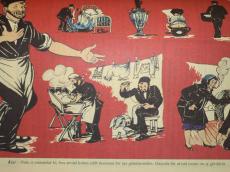|
|
TODAY.AZ / Arts & Entertainment
Molla Nasreddin: a weapon against injustice
14 March 2016 [19:30] - TODAY.AZ

By Laman Ismayilova
At all times the best weapon against injustice and snobbery was the sense of humour.
It's a perfect description for "Molla Nasraddin," the eight-page weekly, satirical magazine, which has played an invaluable role in the history of the Azerbaijani press.
The magazine was first published in Tbilisi on April 7, 1906 and could print 340 issues until 1917. The publication was published later in Tabriz with eight issues printed in 1921, and then in Baku from 1922 to 1931, publishing overall 400 issues.
"Molla Nasraddin" was something revolutionary for that period, criticizing the political elite of Russia and Persia and focusing on such topics as corruption, snobbery, ignorance, religious fanaticism, equal rights for women as well as freedom of expression and preservation of national language and traditions.
The publication fully reflected the country's socio-political life in the early twentieth century. Jalil Mammadgulizade, great satirical writer of that period, who founded the magazine, used to say that "Molla Nasraddin" was born by the time itself".
The name "Molla Nasraddin" was inspired by the 13th century Sufi wise man with a good sense of humor. His stories had a subtle humour and was very popular in public.
The character was popular among the tribes of the Turkic world and could penetrate into Persian, Arabian, African and Indian cultures.
Unlike other publications of that time," Molla Nasreddin" also addressed uneducated people.
The journal used satirical verses, stories and cartoons to convey its messages to the the society.
The magazine regularly published the works of talented Azerbaijani writers and pressmen, such as M.A.Sabir, N.Narimanov, A.Haqverdiyev, M.S.Ordubadi, O.F.Nemanzadeh, Ali Nazmi, A.Gamkusar etc.
One of the main factor gaining great popularity to Molla Nasreddin was the poetry of ?abir, an outstanding poet-innovator of Azerbaijan, whose satirical poems were regularly published in the paper until his death in 1911.
The poet wrote about arbitrariness of Tsarist officials, landowners, the down-trodden status of women and the social situation of the working people.
The magazine campaigned for women's rights also played an important part on giving of a voting right to the woman of Azerbaijan (1919), the first ever move in the Muslim Wast.
However, bold and denunciative articles provoked a widespread discontent among the political elite of that time.
The magazine was banned several times in 1912, 1914 and 1917.
Despite all odds, the publication managed to stay in print over 25 years (1906-1931).
The editor of the magazine was a renowned writer holding an honorable place in the history of Azerbaijani satire and realism.
Mammadguluzadeh wrote in many genres including plays, essays and short stories.
His most famous works include "The Disappearance of the Donkey" (part of his Stories from the village of Danabash series), The Iranian Constitution, The Corpses and The Madmen Gathering, The Lamb etc.
The great and selfless journalist died on January 4th, 1932, from brain haemorrhage.
A drama theatre in Nakhchivan, a street in Baku, the city of Jalilabad and the town of Jalikand were named after him.
The House-Museum of prominent Azerbaijani figure of the twentieth century Jalil Mamedguluzadeh was opened in 1977.
The House-Museum regularly carries out activities by holding exhibitions to allow the public to learn more about the life and creativity of greatest Azerbaijani satirist.
Today, when the struggle between good and evil have no clear boundaries satire and a good sense of humour remain the best way to overcome the obstacles of life.
URL: http://www.today.az/news/entertainment/148827.html
 Print version
Print version
Connect with us. Get latest news and updates.
See Also
- 21 November 2025 [19:11]
Mingachevir Theater to host master classes on theater art - 21 November 2025 [18:29]
Uzeyir Hajibayli's musical comedy captures hearts with its timeless wit - 21 November 2025 [17:46]
Mugham concert captivates audience in Baku - 21 November 2025 [17:39]
Tirana hosts major Azerbaijani carpet exhibition marking UNESCO anniversary - 21 November 2025 [14:11]
Short documentary 'My Name is Oil' screened at int'l film festival - 21 November 2025 [13:16]
Professors of Baku Music Academy join int'l music contest - 20 November 2025 [12:30]
Baku hosts exhibition of Uzbek miniature master Jahangir Ashurov - 19 November 2025 [15:38]
Uzeyir Hajibayli's operetta warmly received in Ashgabat - 19 November 2025 [14:41]
Culture Ministry announces interview stage for special competition of art schools and centers - 19 November 2025 [13:06]
People's Artist Roza Jalilova passes away
Most Popular
 Azerbaijan, Israel hold fourth joint commission meeting in Jerusalem
Azerbaijan, Israel hold fourth joint commission meeting in Jerusalem
 Victim testimonies heard as trial of Ruben Vardanyan continues in Baku Military Court
Victim testimonies heard as trial of Ruben Vardanyan continues in Baku Military Court
 Baku hosts second day of International Banking Forum
Baku hosts second day of International Banking Forum
 Turkiye expands its African sphere of influence with bold Libya shift
Turkiye expands its African sphere of influence with bold Libya shift
 AzInTelecom participates as key partner at 9th International Banking Forum
AzInTelecom participates as key partner at 9th International Banking Forum
 IFC marks 30 years of support for Azerbaijan’s economic development
IFC marks 30 years of support for Azerbaijan’s economic development
 Shein, Temu, AliExpress toys pose risks to children
Shein, Temu, AliExpress toys pose risks to children
